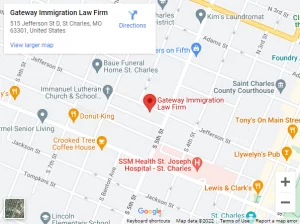Start your immigration journey by knowing how US consular processing works
Consular processing is the usual procedure for a would-be immigrant traveling to the US from a foreign country to apply for and get US legal permanent residence (a ‘green card’). Its defining feature is that, after some interaction with the US Citizenship and Immigration Services (USCIS), the immigrant will deal mainly with and attend a visa interview at a US embassy or US consulate, most likely in the immigrant’s home country. But how does consular processing work in the US?
The Gateway Immigration Law Firm is here to provide you with the answers. We will explain the process and provide you with the resources you need to navigate your immigration case successfully in this article. Read on to learn more about how US Consular Processing works and how the US immigration lawyers at Gateway Immigration Law Firm can help you.
What is Consular Processing?
Consular processing refers to the process by which a person seeking to arrive in the US files for green card status (an application for legal permanent residence) via a United States consulate or embassy in their home country. This entails filing documents and forms to the US consulate, getting a medical examination done as instructed by the consulate, and going through an interview.
Consular processing, however, can be regarded as ‘Part 2’ of the application process for a green card. ‘Part 1’ is often the submission and approval for an I-130 application on behalf of the immigrant by a relative who is a US citizen or legal permanent resident, the immigrant’s employer securing a labor certification as well as the approval of an I-140 petition, or the immigrant’s selection in the diversity visa lottery. The application is sent to the appropriate US consulate or embassy following some further paperwork.
Only after being interviewed by a US consular officer and approval of an immigrant’s visa may an intending immigrant enter the United States and claim legal permanent resident status (LPR).
What are the Different Types of Consular Processing?
There are two types of consular processing: adjustment of status and direct consular processing.
- Adjustment of Status: It is the process of shifting from a nonimmigrant status (e.g., tourist visa, student visa, etc.) to permanent resident status (green card holder) when you are already physically present in the United States. In other words, you may be able to get a green card without having to go back home to finish the visa application process.
Adjustment of status is one of two options for acquiring an immigrant visa (green card) to the United States. If an applicant is not qualified for adjustment of status, they must apply through consular processing. If the applicant is already in the US, adjustment of status and consular processing may be available options.
- Direct Consular Processing: When you apply for a green card via consular processing, the US immigration officers in a consulate or embassy in your home country handle your application. Consular processing is the standard application approach for green card applicants who are filing outside of the United States. Direct Consular Filing (DCF) is a quick procedure for filing Form I-130, which serves as the foundation for all family-based green card applications.
Which Immigrants are Required to Go Through a Consular Processing?
Most immigrants have little option but to choose consular processing for the application for their green card, specifically if they are currently residing abroad. The choice to visit the United States and finish the green card application is rarely offered.
However, a small number of immigrants who already reside in the US, especially those who have a valid visa or arrived with inspection and are direct relations of an American citizen, may pursue an alternative process called adjustment of status, meaning you will need to submit your papers and have your interview in a USCIS location rather than visiting or interacting with a US consulate.
Nonetheless, many immigrants residing in the US cannot utilize an adjustment of the status method, particularly those whose visa stay has ended or who came into the country illegally. Without a doubt, these people will be ordered to exit the United States and seek consular processing. However, this poses risks to those residing illegally in the US.
Also, keep in mind that you must not visit the United States on a tourist visa in the hopes of changing your status. This might be deemed as visa fraud, resulting in the rejection of your green card application.
You Have Stayed Illegally in the US, and You Left the United States for Consular Processing: How Does US Consular Processing Work in this Scenario?
For illegal aliens staying in the United States for a minimum of 180 days, consular processing may result in a ban on returning rather than a green card. They become liable for sanctions for their illegal stay if they leave the United States. Even if the requirements for green card status are met, the consulate is required by law to prevent these illegal aliens from entering the United States for three years once it has been proven that their illegal stay has lasted from 180 days to one year, or 10 years if the illegal stay was one year or longer.
Consult the immigration attorney at Gateway Immigration Law Firm if this is your situation. A waiver is available through the USCIS (on Form I-601A), but it is hard to obtain approval for.
Documentation Requirements for Consular Processing
When your I-130 or I-140 application was filed by your family or employer, or when you filed your lottery petition, your address and other information indicated to the US government as to which consulate is going to be the most convenient location for you.
Once your petition is approved or you win the lottery, your file will be sent to the correct consulate by a central agency named the National Visa Center ( or NVC). A lot must happen before the NVC moves your file to a consulate. First, you will be asked to complete an online Choice of Address and Agent form (Form DS-261) by the NVC.
Simultaneously, if you are immigrating via a family member, the NVC will issue a charge to that individual for processing the Affidavit of Support (Form I-864). This is a form your family member must complete and submit, vowing to assist you if needed.
The NVC will send you an invoice for the processing fee of the immigrant visa after it receives your Form DS-261.
What happens after will be determined in part by the embassy where you are interviewed. You and the petitioner will need to fill out several forms and documents and pass a medical examination. Methods vary in terms of where you submit them after you are done and who your reply will come from (it will either come from the consulate or the NVC).
The Consular Interview for an Immigrant Visa to the United States
The last step in acquiring a visa will be an interview with a United States consular officer. Your scheduled interview date will be sent to you in writing. After you have sworn to speak the truth, the government will use the interview to verify the information you provided in your application and examine your medical, financial, and criminal records to determine if you are inadmissible.
If marriage is the basis of your application, the consular officer will also ask personal questions to determine if your marriage is genuine or a scheme to gain a green card for the immigrant.
For security considerations, you may not be granted an immigrant visa during the interview. Instead, you will be requested to return to the embassy to pick up your immigrant visa if all goes smoothly. There will be a limited time when you can enter the US and claim your legal permanent residence status. The actual green card, also known as Form I-551, will be sent to you a few weeks later.
Contact Our Experienced St. Charles, Missouri, Immigration Attorneys Today!
If you are looking for immigration attorneys in St. Charles, Missouri, look no further than Gateway Immigration Law Firm. Our team of attorneys is committed to providing the highest quality of legal services to our clients.
We understand the complexities of the immigration process, and we are devoted to helping our clients navigate it successfully. We will also provide a more thorough answer to the question, “How does consular processing work.” We offer a wide range of services, from family-based immigration to business-related immigration. Call us today to learn more about how we can help you with your immigration needs!







